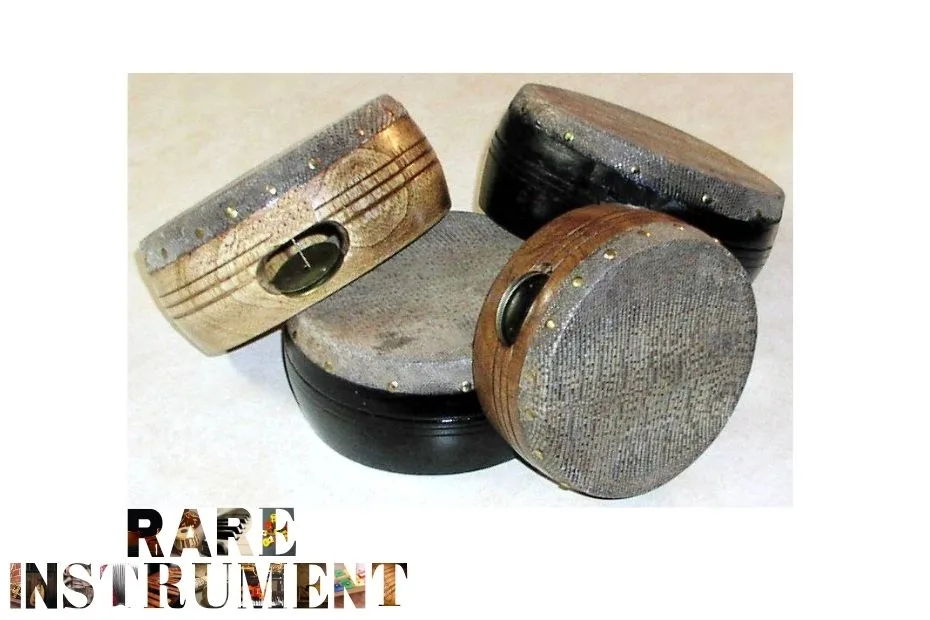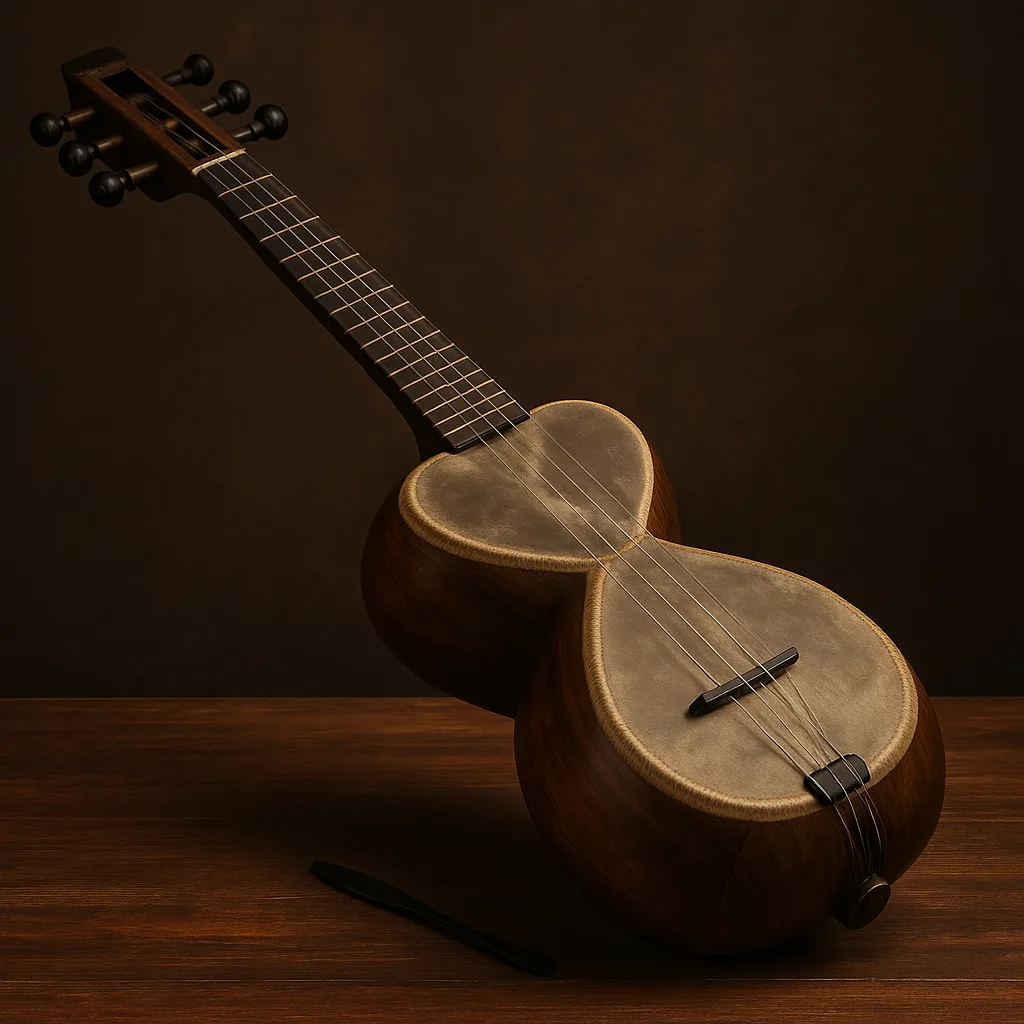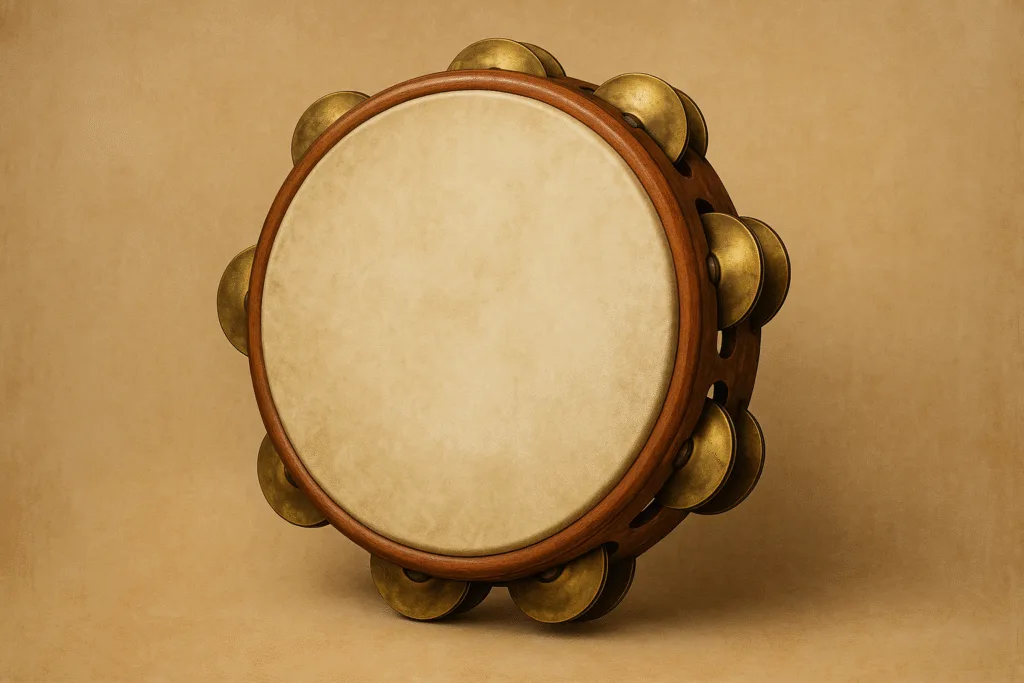Detailed Features of the Kanjira
| Feature | Traditional Form | Modern Variations | Notes |
|---|---|---|---|
| Origin | South India (Carnatic music) | Used globally in fusion and world music | Rooted in temple and folk traditions |
| Diameter | ~7–9 inches (18–23 cm) | Occasional custom sizes (smaller for portability) | Compact size makes it easy to hold with one hand |
| Depth | ~2–3 inches (5–7 cm) | Slightly deeper rims in modern builds | Shallow frame emphasizes agility |
| Head Material | Monitor lizard skin (historically) | Synthetic heads or goat skin (due to wildlife protection laws) | Lizard skin gave unparalleled tonal flexibility |
| Frame | Jackfruit wood or redwood | Plywood, lightweight composites | Sturdy yet light for one-handed play |
| Jingles | One pair of zills set into the frame | Some models use brass or steel pairs | Adds shimmer; less dominant than tambourine jingles |
| Playing Position | Held vertically in the left hand, struck with right | Similar, but some fusion players adapt horizontal hold | Allows pressure modulation on the head |
| Tuning | No mechanical tuning; skin tension controlled by moisture and pressure | Screw-tension or synthetic heads for stable pitch | Players often dampen or moisten the skin mid-performance |
| Primary Role | Rhythmic accompaniment in Carnatic concerts | Solo instrument in fusion and percussion ensembles | Known for dynamic, speech-like tonal inflections |
Historical and Cultural Background
The kanjira has its origins in South India, where it developed as part of Carnatic classical music. It evolved from folk frame drums used in temple rituals and devotional contexts. By the 19th century, it became a staple of Carnatic ensembles, completing the percussion trio of mridangam, ghatam, and kanjira.
Historically, its head was made from monitor lizard skin, which allowed players to bend and modulate pitch dramatically. Due to wildlife conservation laws, today’s kanjiras use goat skin or synthetic materials, preserving playability while protecting endangered species.
The instrument symbolizes South Indian rhythmic artistry. Its ability to mimic vocal phrasing and execute lightning-fast patterns makes it both an accompanying and a soloistic instrument in Carnatic concerts. UNESCO recognizes Carnatic music as part of the intangible cultural heritage of humanity, and the kanjira is inseparable from this tradition.
Construction and Acoustic Design
The Compact Frame
The kanjira’s small, lightweight frame—traditionally made of jackfruit wood—allows it to be held comfortably in one hand. Its shallow depth ensures crisp resonance.
The Head
The lizard-skin head gave unmatched flexibility: by pressing with the left hand, a player could achieve microtonal inflections and dramatic bass bends. Modern goat-skin or synthetic heads strive to replicate this responsiveness but require different playing adjustments.
The Jingle
A single pair of metal discs adds sparkle, though unlike a tambourine, it plays a supporting role. The jingle enriches rhythm without overpowering the drum’s tonal qualities.
Terminology and Playing Techniques
Kanjira playing uses the solkattu (spoken rhythmic syllables) of Carnatic music. Common strokes include:
- Tha: A sharp strike near the edge.
- Dhi: A resonant tone with controlled jingle vibration.
- Nam: A closed stroke with muted resonance.
- Chap: A slap producing a bright pop.
By combining strokes with hand pressure, players create gamakas (ornamental bends) similar to melodic embellishments in Carnatic singing. This gives the kanjira a speech-like quality unmatched by most frame drums.
Musical Context
In Carnatic Ensembles
The kanjira usually supports the mridangam, adding brightness and rhythmic dialogue. It engages in tani avartanam (percussion solos), where virtuosos display mathematical rhythmic improvisations.
Global Adaptations
In recent decades, the kanjira has traveled far beyond South India. Its portability and expressive sound attract world percussionists. It now features in fusion, jazz, and world music ensembles, often alongside Middle Eastern frame drums, cajón, or tabla.
Notable Masters
The kanjira’s prominence owes much to Harishankar, considered the undisputed master of the instrument in the 20th century. His blazing speed and melodic command elevated the kanjira from a supporting role to a soloist’s voice. Other celebrated artists include Selvaganesh Vinayakram, who brought the instrument into global fusion through collaborations with Shakti and John McLaughlin.
Practical Advice for Learners
- Head care: Natural heads should be slightly moistened before playing for flexibility; avoid over-wetting.
- Hand conditioning: Regular practice strengthens finger agility and skin resistance against blisters.
- Size choice: Beginners may prefer slightly smaller kanjiras for easier grip.
- Fusion tips: Experiment with microphones and light EQ to capture its subtle bass bends in amplified settings.
Care and Maintenance
Natural skins are sensitive to humidity and temperature. Keep the instrument stored in stable conditions. Avoid exposing it to direct sunlight, which can crack the head. Synthetic-headed kanjiras offer durability but may lack the warmth and flexibility prized in traditional performance.
Listen to the Kanjira
Here is a legendary solo by Harishankar, demonstrating the kanjira’s unmatched expressiveness:
https://www.youtube.com/watch?v=Y-5Zp5R5Hlk
A Global Voice
Though compact, the kanjira embodies the spirit of South Indian rhythm. Its buzzing timbre, lightning-fast responses, and vocal inflections make it one of the world’s most unique percussion instruments. From Carnatic temples to international stages, the kanjira continues to inspire, adapt, and thrive.
References



